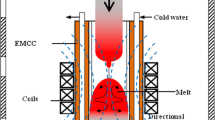Abstract
Background
Indirect cooling method is an alternative scheme for magnetic alloy (MA)-loaded cavity because of the feasible structure and MA core treatment process. Stable and long-term operation is not possible without a powerful cooling system for the high-power MA cavity.
Purpose
The paper reports a method to evaluate the cooling efficiency of an indirect cooling structure for high-power-loss MA cavity.
Methods
Two types of helix metallic cooling plate were designed and checked by CFX code considering the average power loss more than 0.13 W/cc. In order to enhance the heat-transfer efficiency between the non-flatness surface of the MA core and metallic cooling plate, a filling material with high thermal conductivity is needed. Different commercial filling materials were investigated, and a high-power test bench was developed to assess the cooling efficiency. A parametric fitting method was adopted to qualify the heat-transfer coefficient according to the temperature rising curve.
Conclusion
The results indicate that the experimental data maintain good consistency with the CFX simulation results and the cooling structure meets the high-power-loss cooling requirement. The heat-transfer capability of the filling was influenced by the thickness of heat-transfer materials and the painting process. The heat-transfer performance of the thermal grease is better than that of the thermal gasket even though the latter has a higher thermal conductivity. The virtual thermal conductivity of the filling material was less than the product index and affirmed by the CFX transient simulation.









Similar content being viewed by others
References
M. Yamamoto, M. Fujieda, Y. Mori et al., Multi-harmonic acceleration with high gradient MA cavity at HIMAC, in Proceedings of the 1999 Particle Accelerator Conference (Cat. No.99CH36366) (IEEE, New York, 1999). https://doi.org/10.1109/PAC.1999.795381
C. Ohmori, M. Kanazawa, K. Noda et al., A multi-harmonic RF system using a MA cavity. Nucl. Instrum. Methods Phys. Res. Sect. A (Accel. Spectrom. Detect. Assoc. Equip. 547(2–3), 249–258 (2005)
C. Ohmori, K. Hara, K. Hasegawa et al., Air-cooled magnetic alloy cavity for J-PARC doubled rep.-rate scenario, in 5th International Particle Accelerator Conference (JACoW Publishing, Dresden, Germany, 2014)
M. Kanazawa, T. Misu, A. Sugiura et al., RF cavity with co-based amorphous core. MA cavity. Nucl. Instrum. Methods Phys. Res. Sect. A (Accel. Spectrom. Detect. Assoc. Equip. 566(2), 195–204 (2006)
M. Nomura, M. Yamamoto, A. Schnase et al., The origin of magnetic alloy core buckling in J-PARC 3 GeV RCS. Nucl. Instrum. Methods Phys. Res. Sect. A (Accel. Spectrom. Detect. Assoc. Equip. 623(3), 903–909 (2010)
T. Uesugi, Y. Mori, C. Ohmori et al., Direct-cooling MA cavity for J-PARC synchrotrons, in Proceedings of the Particle Accelerator Conference, 2003. PAC 2003 (IEEE, 2003)
Y. Morita, Development of a new RF accelerating cavity loaded with magnetic alloy cores cooled by a chemically inert liquid for stabilizing and enhancing the performance of J-PARC Ring accelerator. Doctor thesis
S. Narumanchi, M. Mihalic, K. Kelly et al. Thermal interface materials for power electronics applications: Preprint, in Conference on Thermal & Thermomechanical Phenomena in Electronic Systems (IEEE, 2008)
Y. H. Su, Y. P. Liu, D. Vasic et al., Power enhancement of piezoelectric transformers by adding thermal pad, in Proceedings of SPIE - The International Society for Optical Engineering (2012). https://doi.org/10.1117/12.915496
T. Misu, A. Sugiura, S. Hojo et al., Indirect “one-side” cooling method of a magnetic-alloy loaded RF cavity. Phys. Rev. Spec. Top. Accel. Beams 7(7), 122002 (2008)
Acknowledgements
Funding was provided by Key Programme (Grant No. 11875270) and Major Research Plan (Grant No. U1832210).
Author information
Authors and Affiliations
Corresponding author
Rights and permissions
About this article
Cite this article
Wu, B., Sun, H., Nie, X. et al. Indirect cooling experiment for magnetic alloy-loaded cavity. Radiat Detect Technol Methods 3, 55 (2019). https://doi.org/10.1007/s41605-019-0133-z
Received:
Revised:
Accepted:
Published:
DOI: https://doi.org/10.1007/s41605-019-0133-z




